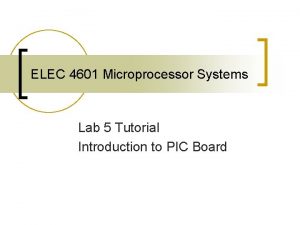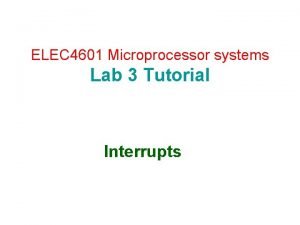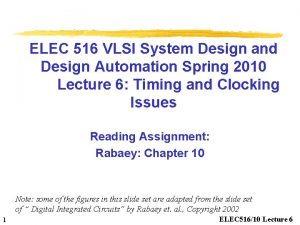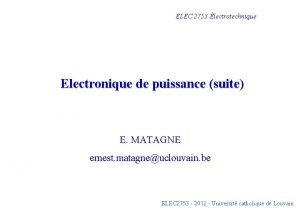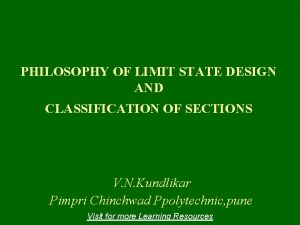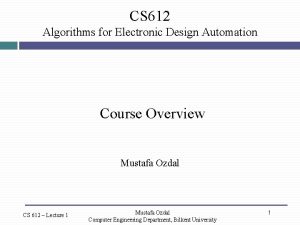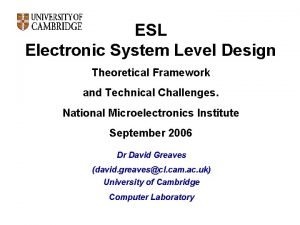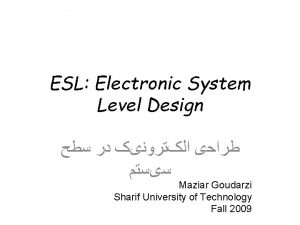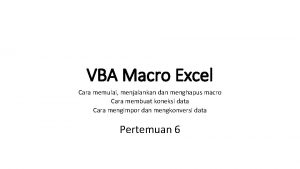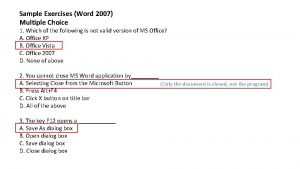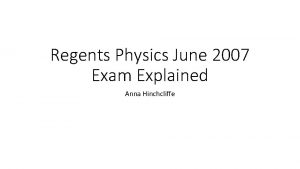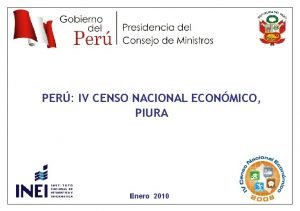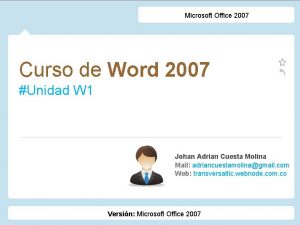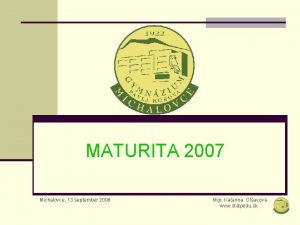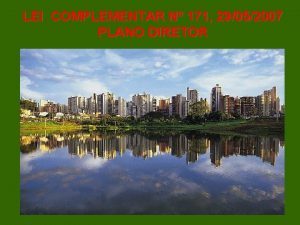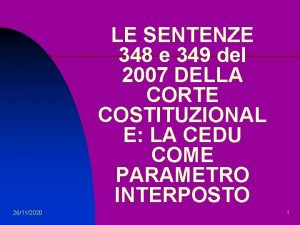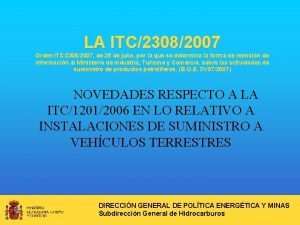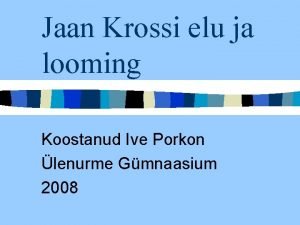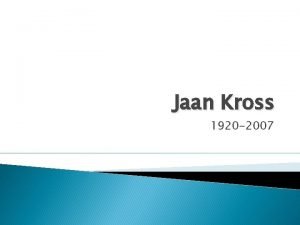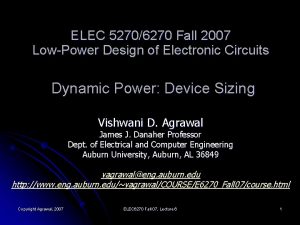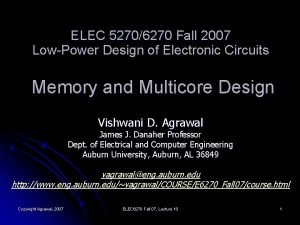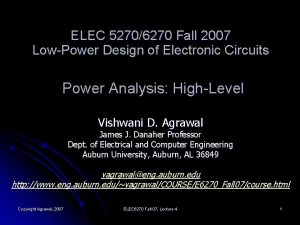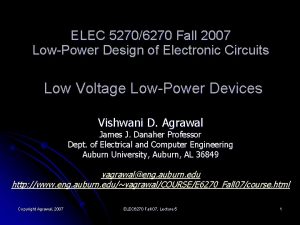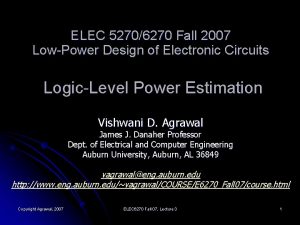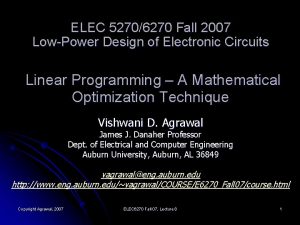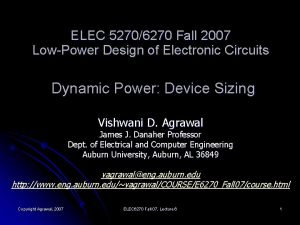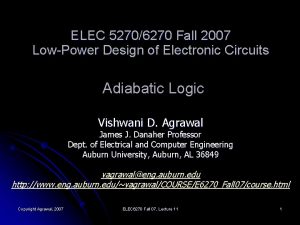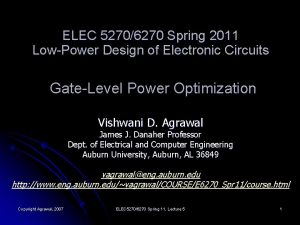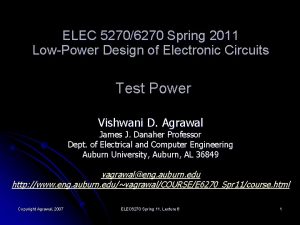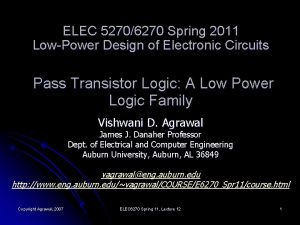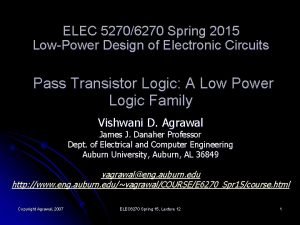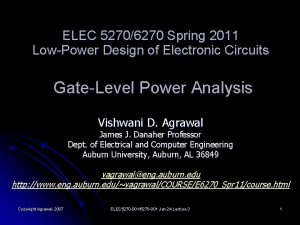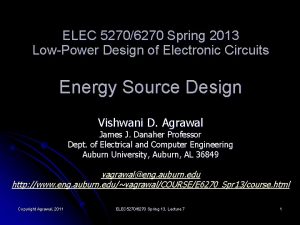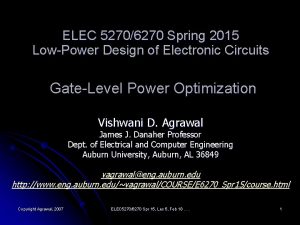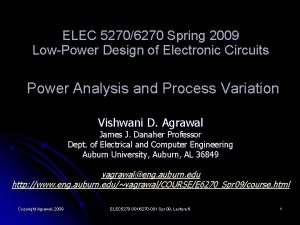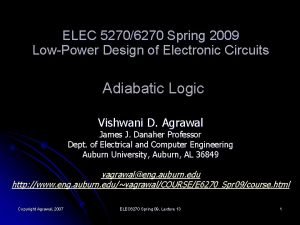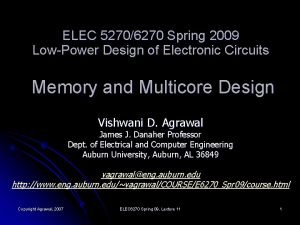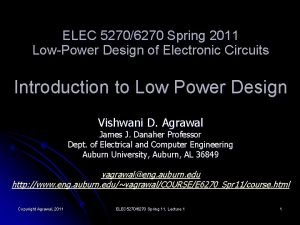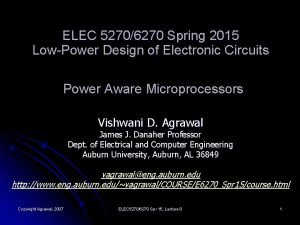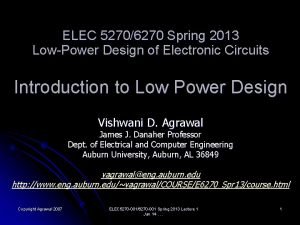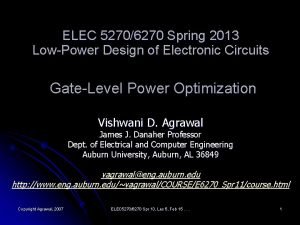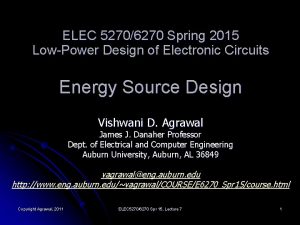ELEC 52706270 Fall 2007 LowPower Design of Electronic






![i(t) = C dv(t)/dt = [V – v(t)] /R dv(t) V – v(t) ─── i(t) = C dv(t)/dt = [V – v(t)] /R dv(t) V – v(t) ───](https://slidetodoc.com/presentation_image_h2/060dabbf394436863d5162131db46a9d/image-7.jpg)
![v(t) = i(t) Copyright Agrawal, 2007 = -t V [1 – exp( ── )] v(t) = i(t) Copyright Agrawal, 2007 = -t V [1 – exp( ── )]](https://slidetodoc.com/presentation_image_h2/060dabbf394436863d5162131db46a9d/image-8.jpg)













![isc, Rise Time and Capacitance Isc(t) = Copyright Agrawal, 2007 -t VDD[1 - exp(─────)] isc, Rise Time and Capacitance Isc(t) = Copyright Agrawal, 2007 -t VDD[1 - exp(─────)]](https://slidetodoc.com/presentation_image_h2/060dabbf394436863d5162131db46a9d/image-22.jpg)



















- Slides: 41

ELEC 5270/6270 Fall 2007 Low-Power Design of Electronic Circuits Dynamic and Static Power in CMOS Vishwani D. Agrawal James J. Danaher Professor Dept. of Electrical and Computer Engineering Auburn University, Auburn, AL 36849 vagrawal@eng. auburn. edu http: //www. eng. auburn. edu/~vagrawal/COURSE/E 6270_Fall 07/course. html Copyright Agrawal, 2007 ELEC 6270 Fall 07, Lecture 2 1

n. MOS Logic (Inverters) For logic 1 input, continuous static power is dissipated. Pseudo-n. MOS Saturated-load n. MOS R. C. Jaeger and T. N. Blalock, Microelctronic Circuit Design, Third Edition, Mc. Graw-Hill, 2006, Chapter 6. Copyright Agrawal, 2007 ELEC 6270 Fall 07, Lecture 2 2

CMOS Logic (Inverter) No static leakage path exists for either 1 or 0 input. F. M. Wanlass and C. T. Sah, “Mamowatt Logic using Field. Effect Metal-Oxide-Semiconductor Triodes, ” IEEE International Solid-State Circuits Conference Digest, vol. IV, February 1963, pp. 32 -33. Copyright Agrawal, 2007 ELEC 6270 Fall 07, Lecture 2 3

Components of Power l Dynamic l Signal transitions l Logic activity l Glitches l Short-circuit l Static l Leakage Copyright Agrawal, 2007 Ptotal = = ELEC 6270 Fall 07, Lecture 2 Pdyn + Pstat Ptran + Psc + Pstat 4

Power of a Transition: Ptran Ron VDD ic(t) vi (t) vo(t) CL R = large Ground Copyright Agrawal, 2007 ELEC 6270 Fall 07, Lecture 2 5

Charging of a Capacitor R t=0 i(t) V v(t) C Charge on capacitor, q(t) = C v(t) Current, i(t) = C dv(t)/dt Copyright Agrawal, 2007 = dq(t)/dt ELEC 6270 Fall 07, Lecture 2 6
![it C dvtdt V vt R dvt V vt i(t) = C dv(t)/dt = [V – v(t)] /R dv(t) V – v(t) ───](https://slidetodoc.com/presentation_image_h2/060dabbf394436863d5162131db46a9d/image-7.jpg)
i(t) = C dv(t)/dt = [V – v(t)] /R dv(t) V – v(t) ─── = ───── dt RC dv(t) dt ∫ ───── = ∫ ──── V – v(t) RC -t ln [V – v(t)] = ── + A RC Initial condition, t = 0, v(t) = 0 → A = ln V -t v(t) = V [1 – exp(───)] RC Copyright Agrawal, 2007 ELEC 6270 Fall 07, Lecture 2 7
![vt it Copyright Agrawal 2007 t V 1 exp v(t) = i(t) Copyright Agrawal, 2007 = -t V [1 – exp( ── )]](https://slidetodoc.com/presentation_image_h2/060dabbf394436863d5162131db46a9d/image-8.jpg)
v(t) = i(t) Copyright Agrawal, 2007 = -t V [1 – exp( ── )] RC dv(t) C ─── dt = ELEC 6270 Fall 07, Lecture 2 V -t ── exp( ── ) R RC 8

Total Energy Per Charging Transition from Power Supply Etrans = = Copyright Agrawal, 2007 ∞ ∫ V i(t) dt = 0 CV ∞V 2 -t ∫ ── exp( ── ) dt 0 R RC 2 ELEC 6270 Fall 07, Lecture 2 9

Energy Dissipated per Transition in Resistance ∞ 2 R ∫ i (t) dt 0 Copyright Agrawal, 2007 = V ∞ -2 t R ── ∫ exp( ── ) dt 2 R 0 RC = 1 2 ─ CV 2 2 ELEC 6270 Fall 07, Lecture 2 10

Energy Stored in Charged Capacitor ∞ ∞ -t V -t ∫ v(t) i(t) dt = ∫ V [1 -exp( ── )] ─ exp( ── ) dt 0 0 RC R RC 1 2 = ─ CV 2 Copyright Agrawal, 2007 ELEC 6270 Fall 07, Lecture 2 11

Transition Power l Gate output rising transition dissipated in p. MOS transistor = CV 2/2 2 l Energy stored in capacitor = CV /2 l Energy l Gate output falling transition l Energy dissipated in n. MOS transistor = CV 2/2 2 Energy dissipated per transition = CV /2 l Power dissipation: l Ptrans = α Copyright Agrawal, 2007 2 Etrans α fck = α fck CV /2 = activity factor ELEC 6270 Fall 07, Lecture 2 12

Components of Power l Dynamic l Signal transitions l Logic activity l Glitches l Short-circuit l Static l Leakage Copyright Agrawal, 2007 Ptotal = = ELEC 6270 Fall 07, Lecture 2 Pdyn + Pstat Ptran + Psc + Pstat 13

Short Circuit Power of a Transition: Psc VDD vi (t) isc(t) vo(t) CL Ground Copyright Agrawal, 2007 ELEC 6270 Fall 07, Lecture 2 14

Short Circuit Current, isc (t) VDD - VTp Vi (t) Volt p-transistor starts conducting n-transistor cuts-off Vo(t) VTn 0 Iscmaxf isc(t) Isc 0 Copyright Agrawal, 2007 t. B t. E ELEC 6270 Fall 07, Lecture 2 1 Time (ns) 15

Peak Short Circuit Current Increases with the size (or gain, β) of transistors l Decreases with load capacitance, CL l Largest when CL = 0 l Reference: M. A. Ortega and J. Figueras, “Short Circuit Power Modeling in Submicron CMOS, ” PATMOS ’ 96, Aug. 1996, pp. 147 -166. l Copyright Agrawal, 2007 ELEC 6270 Fall 07, Lecture 2 16

Short-Circuit Energy per Transition l Escf = = t. E ∫t. B VDD isc(t)dt (t. E – t. B) Iscmaxf VDD / 2 l Escf = tf (VDD - |VTp| - VTn) Iscmaxf / 2 l Escr = tr (VDD - |VTp| - VTn) Iscmaxr / 2 l Escf = Escr = 0, when VDD = |VTp| + VTn Copyright Agrawal, 2007 ELEC 6270 Fall 07, Lecture 2 17

Short-Circuit Energy Increases with rise and fall times of input l Decreases for larger output load capacitance l Decreases and eventually becomes zero when VDD is scaled down but the threshold voltages are not scaled down l Copyright Agrawal, 2007 ELEC 6270 Fall 07, Lecture 2 18

Short-Circuit Power Calculation Assume equal rise and fall times l Model input-output capacitive coupling (Miller capacitance) l Use a spice model for transistors l l T. Sakurai and A. Newton, “Alpha-power Law MOSFET model and Its Application to a CMOS Inverter, ” IEEE J. Solid State Circuits, vol. 25, April 1990, pp. 584 -594. Copyright Agrawal, 2007 ELEC 6270 Fall 07, Lecture 2 19

Short Circuit Power Psc = Copyright Agrawal, 2007 α fck Esc ELEC 6270 Fall 07, Lecture 2 20

Psc, Rise Time and Capacitance VDD Ron vi (t) tf VDD ic(t)+isc(t) vo(t) CL R = large vo(t) tr Ground Copyright Agrawal, 2007 ELEC 6270 Fall 07, Lecture 2 vo(t) ─── R↑ 21
![isc Rise Time and Capacitance Isct Copyright Agrawal 2007 t VDD1 exp isc, Rise Time and Capacitance Isc(t) = Copyright Agrawal, 2007 -t VDD[1 - exp(─────)]](https://slidetodoc.com/presentation_image_h2/060dabbf394436863d5162131db46a9d/image-22.jpg)
isc, Rise Time and Capacitance Isc(t) = Copyright Agrawal, 2007 -t VDD[1 - exp(─────)] vo(t) R↓(t) C ──── = ─────── R↑(t) ELEC 6270 Fall 07, Lecture 2 22

iscmax, Rise Time and Capacitance i Small C vo(t) Large C vo(t) 1 ──── R↑(t) iscmax Copyright Agrawal, 2007 tf t ELEC 6270 Fall 07, Lecture 2 23

Psc, Rise Times, Capacitance For given input rise and fall times short circuit power decreases as output capacitance increases. l Short circuit power increases with increase of input rise and fall times. l Short circuit power is reduced if output rise and fall times are smaller than the input rise and fall times. l Copyright Agrawal, 2007 ELEC 6270 Fall 07, Lecture 2 24

Summary: Short-Circuit Power l l Short-circuit power is consumed by each transition (increases with input transition time). Reduction requires that gate output transition should not be faster than the input transition (faster gates can consume more short-circuit power). Increasing the output load capacitance reduces short-circuit power. Scaling down of supply voltage with respect to threshold voltages reduces short-circuit power; completely eliminated when VDD ≤ |Vtp| + Vtn. Copyright Agrawal, 2007 ELEC 6270 Fall 07, Lecture 2 25

Components of Power l Dynamic l Signal transitions l Logic activity l Glitches l Short-circuit l Static l Leakage Copyright Agrawal, 2007 ELEC 6270 Fall 07, Lecture 2 26

Leakage Power IG Ground Gate VDD R Source Drain n+ Bulk Si (p) Isub IPT IGIDL n+ ID n. MOS Transistor Copyright Agrawal, 2007 ELEC 6270 Fall 07, Lecture 2 27

Leakage Current Components Subthreshold conduction, Isub l Reverse bias pn junction conduction, ID l Gate induced drain leakage, IGIDL due to tunneling at the gate-drain overlap l Drain source punchthrough, IPT due to short channel and high drain-source voltage l Gate tunneling, IG through thin oxide; may become significant with scaling l Copyright Agrawal, 2007 ELEC 6270 Fall 07, Lecture 2 28

Subthreshold Current Isub = μ 0 Cox (W/L) Vt 2 exp{(VGS –VTH ) / n. Vt } μ 0: carrier surface mobility Cox: gate oxide capacitance per unit area L: channel length W: gate width Vt = k. T/q: thermal voltage n: a technology parameter Copyright Agrawal, 2007 ELEC 6270 Fall 07, Lecture 2 29

IDS for Short Channel Device Isub= μ 0 Cox(W/L)Vt 2 exp{(VGS –VTH + ηVDS)/n. Vt} VDS = drain to source voltage η: a proportionality factor W. Nebel and J. Mermet (Editors), Low Power Design in Deep Submicron Electronics, Springer, 1997, Section 4. 1 by J. Figueras, pp. 81 -104 Copyright Agrawal, 2007 ELEC 6270 Fall 07, Lecture 2 30

Increased Subthreshold Leakage Log (Drain current) Scaled device Ic Isub 0 VTH’ VTH Copyright Agrawal, 2007 ELEC 6270 Fall 07, Lecture 2 Gate voltage 31

Summary: Leakage Power l l Leakage power as a fraction of the total power increases as clock frequency drops. Turning supply off in unused parts can save power. For a gate it is a small fraction of the total power; it can be significant for very large circuits. Scaling down features requires lowering the threshold voltage, which increases leakage power; roughly doubles with each shrinking. Multiple-threshold devices are used to reduce leakage power. Copyright Agrawal, 2007 ELEC 6270 Fall 07, Lecture 2 32

Technology Scaling down 0. 7 micron by factors 2 and 4 leads to 0. 35 and 0. 17 micron technologies l Constant electric field assumed l Copyright Agrawal, 2007 ELEC 6270 Fall 07, Lecture 2 33

Constant Electric Field Scaling B. Davari, R. H. Dennard and G. G. Shahidi, “CMOS Scaling for High Performance and Low Power—The Next Ten Years, ” Proc. IEEE, April 1995, pp. 595 -606. l Other forms of scaling are referred to as constant-voltage and quasi-constantvoltage. l Copyright Agrawal, 2007 ELEC 6270 Fall 07, Lecture 2 34

Bulk n. MOSFET Polysilicon Gate W Source Drain n+ n+ L p-type body (bulk) Si. O 2 Thickness = tox Copyright Agrawal, 2007 ELEC 6270 Fall 07, Lecture 2 35

Technology Scaling l l l A scaling factor (S ) reduces device dimensions as 1/S. Successive generations of technology have used a scaling S = √ 2, doubling the number of transistors per unit area. This produced 0. 25μ, 0. 18μ, 0. 13μ, 90 nm and 65 nm technologies, continuing on to 45 nm and 30 nm. A 5% gate shrink (S = 1. 05) is commonly applied to boost speed as the process matures. N. H. E. Weste and D. Harris, CMOS VLSI Design, Third Edition, Boston: Pearson Addison-Wesley, 2005, Section 4. 9. 1. Copyright Agrawal, 2007 ELEC 6270 Fall 07, Lecture 2 36

Constant Electric Field Scaling Device Parameter Scaling Length, L 1/S Width, W 1/S Gate oxide thickness, tox 1/S Supply voltage, VDD 1/S Threshold voltages, Vtn, Vtp 1/S Substrate doping, NA Copyright Agrawal, 2007 ELEC 6270 Fall 07, Lecture 2 S 37

Constant Electric Field Scaling(Cont. ) Device Characteristic β Scaling W / (L tox) S β (VDD – Vt ) 2 1/S Resistance, R VDD / Ids 1 Gate capacitance, C W L / tox 1/S Gate delay, τ RC 1/S Clock frequency, f 1/ τ S CV 2 f 1/S 2 Current, Ids Dynamic power per gate, P Chip area, A 1/S 2 Power density P/A 1 Current density Ids /A S Copyright Agrawal, 2007 ELEC 6270 Fall 07, Lecture 2 38

Problem: A Design Example l l A battery-operated 65 nm digital CMOS device is found to consume equal amounts (P ) of dynamic power and leakage power while the short-circuit power is negligible. The energy consumed by a computing task, that takes T seconds, is 2 PT. Compare two power reduction strategies for extending the battery life: A. B. Clock frequency is reduced to half, keeping all other parameters constant. Supply voltage is reduced to half. This slows the gates down and forces the clock frequency to be lowered to half of its original (full voltage) value. Assume that leakage current is held unchanged by modifying the design of transistors. Copyright Agrawal, 2007 ELEC 6270 Fall 07, Lecture 2 39

Solution: Part A. Clock Frequency Reduction l l Reducing the clock frequency will reduce dynamic power to P / 2, keep the static power the same as P, and double the execution time of the task. Energy consumption for the task will be, Energy = (P / 2 + P ) 2 T = 3 PT which is greater than the original 2 PT. Copyright Agrawal, 2007 ELEC 6270 Fall 07, Lecture 2 40

Solution: Part B. Supply Voltage Reduction l l When the supply voltage and clock frequency are reduced to half their values, dynamic power is reduced to P / 8 and static power to P / 2. The time of task is doubled and the total energy consumption is, Energy = (P / 8 + P / 2) 2 T = 5 PT / 4 =1. 25 PT The voltage reduction strategy reduces energy consumption while a simple frequency reduction consumes more energy. Copyright Agrawal, 2007 ELEC 6270 Fall 07, Lecture 2 41
 Elec 4601
Elec 4601 Elec4601
Elec4601 Elec service plus
Elec service plus Picture recognition
Picture recognition Dec alpha 21264
Dec alpha 21264 Elec
Elec Saif zahir
Saif zahir Superposition electric circuits
Superposition electric circuits Scrip exchange
Scrip exchange Electronic field production
Electronic field production Design of gantry girder as per is 800 2007
Design of gantry girder as per is 800 2007 Electronic design automation course
Electronic design automation course Ekozemelapis
Ekozemelapis Electronic system level design
Electronic system level design Ribbon untuk memulai vba excel adalah
Ribbon untuk memulai vba excel adalah Excel
Excel The mental health act 2007
The mental health act 2007 Delhi fire service act
Delhi fire service act Df 24/1997
Df 24/1997 Bulan ramadhan tahun 2007
Bulan ramadhan tahun 2007 Ogle 2007 blg 368 lb
Ogle 2007 blg 368 lb How to create multiple choice questions in word 2007
How to create multiple choice questions in word 2007 Sale of goods and supply of services act 1980
Sale of goods and supply of services act 1980 June 2007 physics regents answers
June 2007 physics regents answers Excel 2013 power pivot
Excel 2013 power pivot Inei censo 2007 resultados
Inei censo 2007 resultados Public procurement act 2007 as amended
Public procurement act 2007 as amended Excel 2007 ods
Excel 2007 ods Microsoft word 2007 dapat dijalankan dengan menggunakan
Microsoft word 2007 dapat dijalankan dengan menggunakan Ms project 2007
Ms project 2007 Visio professional 2007
Visio professional 2007 Microsoft publisher 2007
Microsoft publisher 2007 Curso word 2007
Curso word 2007 Maturita 2006
Maturita 2006 For chase
For chase Lineamientos de reforma del sector salud
Lineamientos de reforma del sector salud Lei 171 de 2007
Lei 171 de 2007 Sentenze gemelle 348 e 349 del 2007
Sentenze gemelle 348 e 349 del 2007 23082007
23082007 Harga satuan bangunan gedung negara (hsbgn) ta 2021
Harga satuan bangunan gedung negara (hsbgn) ta 2021 Ive porkon
Ive porkon Jaan kross luuletused
Jaan kross luuletused
